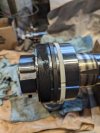Welder Dave
Senior Member
We're the original pins left to turn in the lugs? Seems stupid if they were but wouldn't be too hard to modify. Would be a lot less than expander pins.
Looks like someone beat on the piston in the last pic.


Most of the cylinders that I have rebuilt for electric utility work (diggers and bucket trucks) had nuts. It seems that most backhoes have bolts. Not sure how much it matters, mut I have seen more than one nut with a set screw in it. Most of the nuts I have seen were regular hex elastic stop nuts that we replaced upon rebuild.




I am thinking thread locker.The piston was loose on the rod and the lock nut was loose also, with the set screw being the only thing keeping it from coming all the way off

